|
 Protubera parvispora Protubera parvispora
BiostatusPresent in region - Indigenous. Endemic
Images (click to enlarge)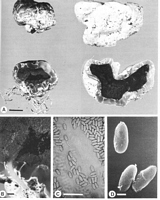
Caption: Fig. 12 Protubera parvispora. A, Basidiomata exterior and in section (PDD 52011). B, Detail of attachment region in section (PDD 52011). C, Basidiospores by bright field (PDD 52011). D, Basidiospores by SEM (PDD 52011). Scale: 1 cm (A), 1 mm (B), 10 µm (C | 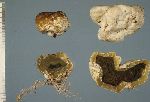
Owner: Ross Beever | 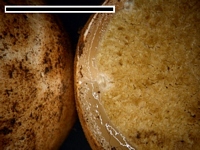
Caption: scale=1cm
Owner: J.A. Cooper | 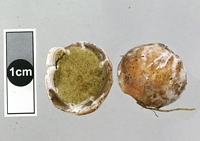
Owner: J.A. Cooper | 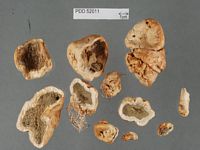
Caption: Dried type specimen
Owner: Herb PDD |
Article: Castellano, M.A.; Beever, R.E. (1994). Truffle-like Basidiomycotina of New Zealand: Gallacea, Hysterangium, Phallobata, and Protubera. New Zealand Journal of Botany 32(3): 305-328 (http://www.rsnz.org/publish/abstracts.php).
Description: Basidiomata up to 5.2 cm diam., globose to depressed, white when fresh, bruising
brown, white to pale yellow brown when dried, surface glabrous and with a cerebriform
appearance; KOH and EtOH negative. Gleba gelatinous, olive brown to greyish olive;
locules up to 1 mm diam., elongate, empty. Rhizomorph single but soon branching, up
to 2 mm diam., concolorous with peridium. Columella dendroid, c. 1 mm diam.,
gelatinous, translucent to grey blue. Taste not noted. Odour nil to faint. Peridium not
easily separable from gleba, 5-6 (-10) mm thick, 2-layered; epicutis 140-250 µm thick, of
hyaline, thin-walled, compact, irregularly shaped, interwoven hyphae, 5-9 µm diam.,
much finer near peridial surface, 2-3 µm diam., with frequent, erect, tapered hyphae
projecting from surface, clamp connections absent; subcutis 5-6 (-10) mm thick, of
hyaline, loosely interwoven, irregularly shaped hyphae, 1-3 µm diam., in a gelatinised
matrix, clamp connections common. Sutures transecting subcutis, frequent, of mostly
hyaline, occasionally pale brown to brown, loosely interwoven hyphae, 1-3 µm diam.,
contiguous with epicutis, and extending intermittently along interface between gleba and
subcutis. Trama of hyaline, thin-walled, loosely interwoven to subparallel hyphae, 1-3
µm diam., in a gelatinised matrix, clamp connections absent. Basidia not observed.
Spores smooth, 4(-5) x 1.5(-2) µm, ellipsoid, apex obtuse, base with slight sterigmal
attachment to sessile; wall <0.5 µm thick. Utricle absent. Spore colour in KOH pale
green singly, green in mass.
Cultures grown from glebal tissue transferred to malt extract agar at 20°C produced
slow-growng (1.6 mm radial growth/week) colonies; after 17 weeks, cultures showed an
irregular periphery, with submerged, hyaline hyphae marginally and felted, white aerial
hyphae centrally.
Habitat: Habitat: epigeous on, to slightly immersed in, rotting wood and other plant material,
sometimes on soil, in podocarp-broadleaf forest. Season: April through November.
Distribution New Zealand.
Notes: ETYMOLOGY: From Latin parvus, small, and sporum, spore, referring to the small
spores.
REMARKS: Protubera parvispora has smaller spores than the Australian P. canescens
Beaton & Malajczuk and South African P. africana Lloyd. with which it is
macroscopically aligned. Two collections [AUCKLAND: Hunua Range Moumoukai
Valley, J.M. Dingley, 11 Jun 194 (PDD 7651, OSC). SOUTHLAND: Maclennan J.R.J.
Moore, Apr 1937 (PDD 8312, OSC): generally match this species but differ somewhat in peridial characters.
|